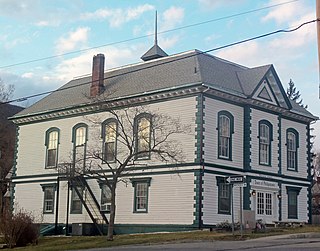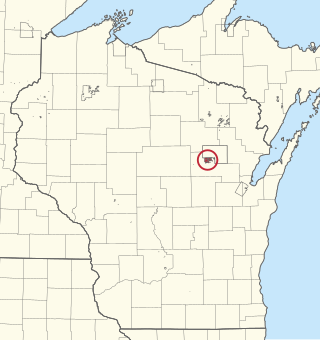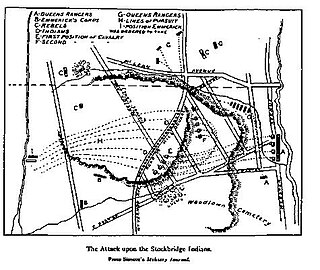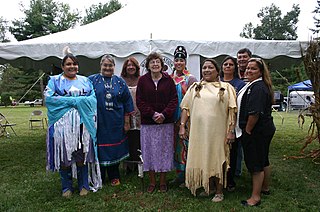
Dutchess County is a county in the U.S. state of New York. As of the 2020 census, the population was 295,911. The county seat is the city of Poughkeepsie. The county was created in 1683, one of New York's first twelve counties, and later organized in 1713. It is located in the Mid-Hudson Region of the Hudson Valley, north of New York City.

Putnam County is a county located in the U.S. state of New York. As of the 2020 census, the population was 97,668. The county seat is Carmel, located within one of six towns comprising the county.

The Mohicans are an Eastern Algonquian Native American tribe that historically spoke an Algonquian language. As part of the Eastern Algonquian family of tribes, they are related to the neighboring Lenape, whose indigenous territory was to the south as far as the Atlantic coast. The Mohican lived in the upper tidal Hudson River Valley, including the confluence of the Mohawk River and into western New England centered on the upper Housatonic River watershed. After 1680, due to conflicts with the powerful Mohawk to the west during the Beaver Wars, many were driven southeastward across the present-day Massachusetts western border and the Taconic Mountains to Berkshire County around Stockbridge, Massachusetts.

Wappinger is a town in Dutchess County, New York, United States. The town is located in the Hudson River Valley region, on the eastern bank of the Hudson River. The population was 28,216 at the 2020 census. The name is derived from the Wappinger Native Americans who inhabited the area. Wappinger comprises three-fourths of the incorporated village of Wappingers Falls, several unincorporated hamlets such as Chelsea, Diddell, Hughsonville, Middlebush, Myers Corners, New Hackensack, and Swartwoutville, and a number of neighborhoods.

Cold Spring is a village in the town of Philipstown in Putnam County, New York, United States. The population was 1,986 at the 2020 census. It borders the smaller village of Nelsonville and the hamlets of Garrison and North Highlands. The central area of the village is on the National Register of Historic Places as the Cold Spring Historic District due to its many well-preserved 19th-century buildings, constructed to accommodate workers at the nearby West Point Foundry. The town is the birthplace of General Gouverneur K. Warren, who was an important figure in the Union Army during the Civil War. The village, located in the Hudson Highlands, sits at the deepest point of the Hudson River, directly across from West Point. Cold Spring serves as a weekend getaway for many residents of New York City.

Town of Kent is a town in Putnam County, New York, United States. The population was 12,900 at the 2020 census. The name is that of an early settler family. The town is in the north-central part of the Putnam County. Many of the lakes are reservoirs for New York City.

Philipstown is a town located in the western part of Putnam County, New York, United States. The population was 9,831 at the 2020 census.

Germantown is a town in Columbia County, New York, United States. The population was 1,936 at the 2020 census, down slightly from 1,954 in 2010. Germantown is located in the south-western part of the county along the east side of the Hudson River.

Fishkill is a town in the southwestern part of Dutchess County, New York, United States. It lies approximately 60 miles (97 km) north of New York City. The population was 24,226 at the 2010 census. Fishkill surrounds the city of Beacon, and contains a village, which is also named Fishkill.

The Great Nine Partners Patent, also known as the "Lower Nine Partners Patent," was a land grant in Dutchess County, New York, made on May 27, 1697, by New York governor Benjamin Fletcher. The parcel included about four miles (6 km) along the Hudson River and was eight to ten miles wide, extending from the Hudson River to the Connecticut border.

The Wappinger were an Eastern Algonquian Munsee-speaking Native American people from what is now southern New York and western Connecticut.

The Stockbridge–Munsee Community, also known as the Mohican Nation Stockbridge–Munsee Band, is a federally recognized Native American tribe formed in the late eighteenth century from communities of so-called "praying Indians", descended from Christianized members of two distinct groups: Mohican and Wappinger from the praying town of Stockbridge, Massachusetts, and Munsee (Lenape), from the area where present-day New York, Pennsylvania and New Jersey meet. Their land-base, the Stockbridge–Munsee Indian Reservation, consists of a checkerboard of 24.03 square miles (62.2 km2) in the towns of Bartelme and Red Springs in Shawano County, Wisconsin. Among their enterprises is the North Star Mohican Resort and Casino.
The Mohegan are an Algonquian Native American tribe historically based in present-day Connecticut. Today the majority of the people are associated with the Mohegan Indian Tribe, a federally recognized tribe living on a reservation in the eastern upper Thames River valley of south-central Connecticut. It is one of two federally recognized tribes in the state, the other being the Mashantucket Pequot, whose reservation is in Ledyard, Connecticut. There are also three state-recognized tribes: the Schaghticoke, Paugusett, and Eastern Pequot.

The Stockbridge Militia was a Native American military unit from Stockbridge, Massachusetts which served in the Continental Army during the American Revolutionary War. The militia unit was composed mostly of Mohican, Wappinger, and Munsee from the Stockbridge area. While most northeastern tribes, such as Joseph Brant's Mohawks, aligned themselves with the British, the Stockbridge tribes allied with the American Patriots. Led by Jehoiaikim Mtohksin and Abraham Nimham, they were the first group of Native Americans to fight for the cause of American independence during the Revolutionary War.

The Esopus was a tribe of Lenape (Delaware) Native Americans who were native to the Catskill Mountains of what is now Upstate New York. Their lands included modern-day Ulster and Sullivan counties.

The Munsee are a subtribe and one of the three divisions of the Lenape. Historically, they lived along the upper portion of the Delaware River, the Minisink, and the adjacent country in New York, New Jersey, and Pennsylvania. They were prominent in the early history of New York and New Jersey, being among the first Indigenous peoples of that region to encounter European colonizers.

The Philipse Patent was a British royal patent for a large tract of land on the east bank of the Hudson River about 50 miles north of New York City. It was purchased in 1697 by Adolphus Philipse, a wealthy landowner of Dutch descent in the Province of New York, and in time became today's Putnam County.

Mount Nimham is a 1,273-foot-tall (388 m) mountain in Hudson Highlands of New York. It is located northwest of Carmel in Putnam County. Nimham Mountain is named after Chief Daniel Nimham of the Wappinger tribe. In 1940, an 82-foot-6-inch-tall (25.15 m) steel fire lookout tower was built on the mountain. The tower ceased fire lookout operations at the end of the 1988 fire lookout season and was officially closed the next year. The tower appears on the National Historic Lookout Register and is still open to the public.

The Rombout Patent was a Colonial era land patent issued by King James II of England in 1685 sanctioning the right of Francis Rombouts and his partners Stephanus Van Cortlandt and Jacobus Kip to own some 85,000 acres (34,000 ha) of land they had purchased from Native Americans. The Patent included most of what is today's southern Dutchess County, New York.

Abraham Nimham was an American man who was the son of warrior and emissary Daniel Nimham and a leader of the Wappinger tribe. During the Revolutionary War, he served with his father in the Stockbridge Militia, often accompanying him on diplomatic and recruiting missions.



















